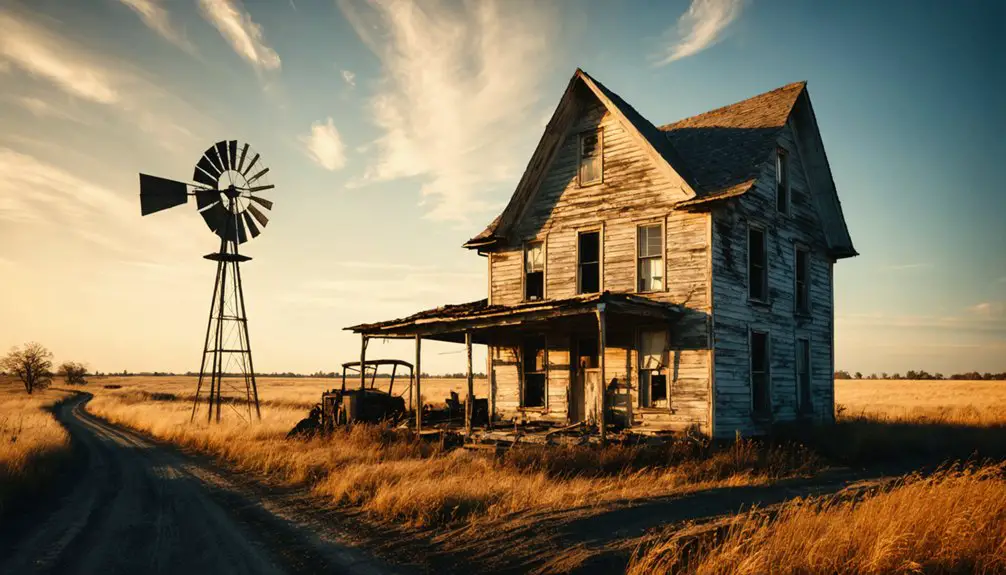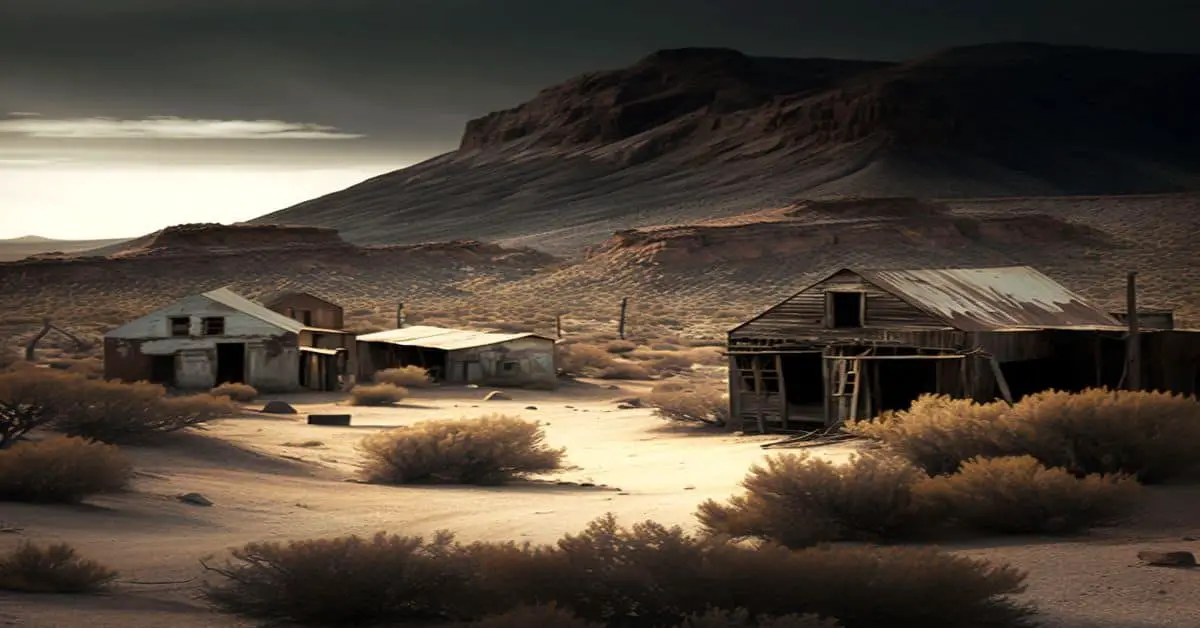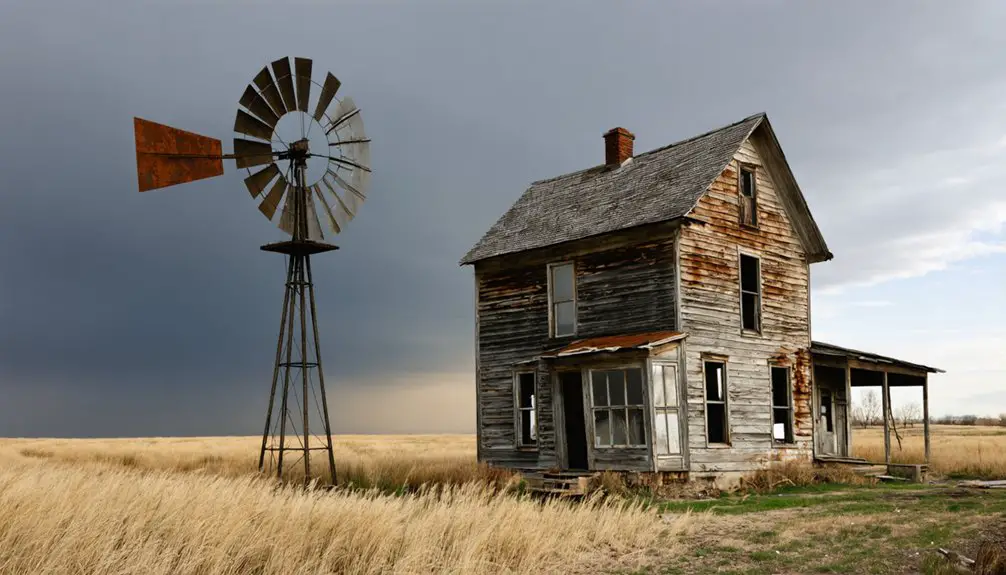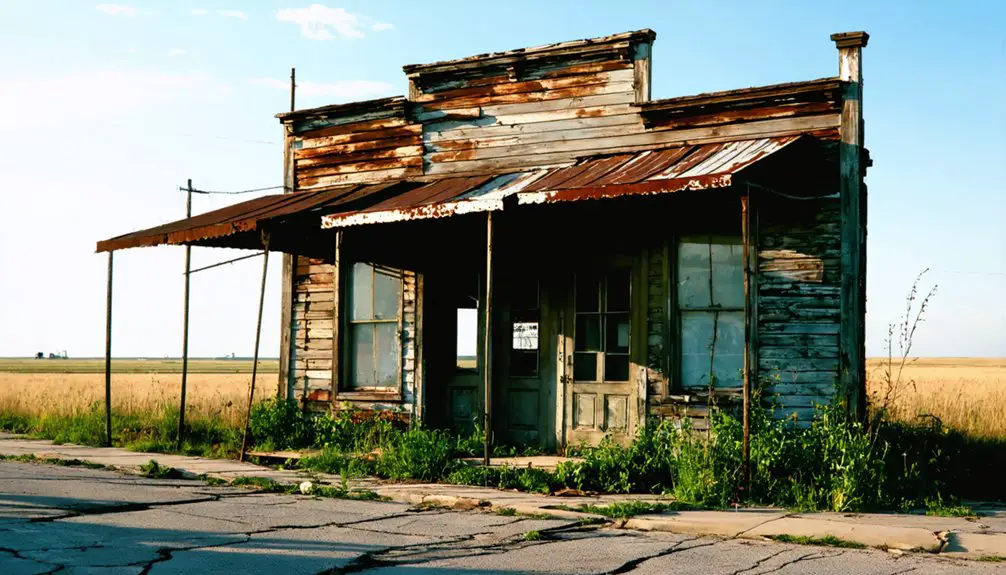You’ll find Unit, Nebraska among the state’s forgotten railroad settlements, established during the westward expansion of the 1800s along the Chicago, Burlington and Quincy Railroad line. Despite its initial promise, the town’s isolation from major transportation routes led to its eventual decline. Today, scattered ruins, deteriorating structures, and aging gravestones tell the story of this once-vibrant frontier community. The deeper layers of Unit’s history reveal a fascinating tale of boom, bust, and pioneer perseverance.
Key Takeaways
- Unit emerged as a railroad settlement in late 1800s Nebraska but struggled due to lack of direct railroad connections.
- The community centered around a one-room schoolhouse, church, and post office during its prime years.
- Economic decline began with the Financial Panic of 1857 and worsened due to isolation from major transportation routes.
- Notable resident Jack Luckert preserved local history by relocating a schoolhouse, maintaining Unit’s historical legacy.
- Today, Unit exists as a ghost town with deteriorating structures, scattered artifacts, and aging gravestones marking its past.
The Rise of Unit as a Railroad Settlement
The rise of Unit, Nebraska exemplifies the transformative impact of America’s westward railroad expansion in the late 1800s.
As railroads pushed west across 1800s America, small towns like Unit, Nebraska emerged as vital markers of the nation’s expanding frontier.
You’ll find Unit’s origins deeply rooted in the government’s strategic land grant policies, which gave railroads extensive tracts alongside their tracks to encourage development in Nebraska’s frontier.
When the Chicago, Burlington and Quincy Railroad established its line connecting Alliance to Edgemont in 1889, Unit emerged as a crucial stop along this route. The challenging terrain required trains to navigate two horseshoe curves while climbing 800 feet in elevation.
The railroad’s presence sparked economic growth as the settlement became a hub for freight handling, livestock shipping, and essential railroad operations. Similar to other rail towns, Unit developed grain elevators to facilitate the transportation of agricultural products to distant markets.
You can trace Unit’s development to the classic “checkerboard” pattern of railroad-owned territories, where the combination of railroad land sales and federal homesteading programs attracted settlers seeking opportunities in Nebraska’s expanding frontier.
Daily Life in Unit’s Prime Years
Living in Unit during its prime years offered residents a rich tapestry of social connections and daily routines that shaped the frontier community’s character.
You’d find yourself drawn to the one-room schoolhouse and church, which served as essential community hubs where neighbors gathered for both education and celebration. Much like in Buckskin Joe, the local postmaster played a central role in connecting residents through mail and community updates. Daily routines revolved around the local stores and mills, where you’d exchange news while conducting business. A variety of general merchandise stores operated simultaneously to serve the growing population.
- Social gatherings centered around lively dance halls and baseball games
- Community stores doubled as informal meeting spots for sharing local news
- Churches and schools anchored both spiritual life and social connections
Your economic activities would’ve included farming or mining, with cream and egg deliveries creating regular opportunities for social interaction.
The town’s dynamism depended on these daily exchanges, where business and pleasure intertwined naturally.
Key Buildings and Landmarks
Remnants of Unit’s architectural heritage stand as silent witnesses to the town’s prosperous past, with key structures defining its historical footprint.
You’ll find the historic architecture most evident in the former post office, which served as the town’s communication hub, and the one-room schoolhouse that educated local children until the mid-1900s. The local buildings reflect the typical abandoned business sites that characterize Nebraska’s ghost towns.
The community church, with its period-specific design and adjacent cemetery, remains a reflection of early settlers’ spiritual life and community gatherings.
The general store‘s foundation and remnants of the train depot reveal Unit’s commercial significance, while scattered ruins of the dance hall and livery stable hint at the town’s social fabric.
Today, these weathered structures, along with preserved artifacts at the county museum, tell the story of Unit’s rise and eventual decline. Similar to Welcome sign markers in towns like Broadwater, Unit’s entrance once greeted visitors with proud declarations of its presence.
Economic Activities and Local Commerce
While Unit’s architectural remnants tell of its physical presence, examining its economic narrative reveals a stark tale of ambitious beginnings and swift decline.
The Financial Panic of 1857 devastated local commerce and land speculation across Nebraska Territory. You’ll find that early speculators drove land prices skyward, but the Panic of 1857 shattered these dreams, triggering bank failures and plummeting real estate values.
Unit’s attempts at establishing trade routes faltered as nearby towns like Omaha and Plattsmouth captured key commercial opportunities. Similar to how the Amboy Mill sustained its town’s economy until the 1940s, Unit struggled to maintain a lasting industrial foothold.
As rival settlements seized vital trade routes, Unit’s commercial aspirations withered, leaving the town stranded in economic isolation.
- Agricultural exports struggled without reliable railroad connections
- Wagon traffic on Mormon Military Road proved insufficient for sustained growth
- River towns outcompeted Unit for crucial steamboat commerce
The town’s isolation from major transportation arteries sealed its fate.
Without direct rail access or river traffic, Unit couldn’t maintain the commercial momentum needed for survival, and its business community gradually dissolved as residents sought opportunities elsewhere.
The Railroad’s Impact on Unit
Despite Unit’s proximity to Nebraska’s expanding rail network in the 1860s, the town’s fate was sealed by its inability to secure a direct railroad connection.
While neighboring communities thrived with Union Pacific’s rapid expansion through central Nebraska, Unit remained on the periphery of this transportation evolution. Early settlers relied on boats and ferries for transportation before railroads arrived.
You’ll find that railroad significance in the region can’t be overstated. Communities with rail access enjoyed ten-cent-per-mile passenger fares, up to 140 daily trains, and essential freight services.
These rail-connected towns attracted workers, merchants, and settlers, while offering farmers broader market access for their goods. Without direct rail service, Unit couldn’t compete with nearby settlements that leveraged railroad connectivity for economic growth, despite the legislature’s generous land grants of up to 2,000 acres per mile to encourage rural rail development. The completion of the first transcontinental railroad in 1869 further isolated communities like Unit that lacked rail connections.
Factors Leading to Unit’s Decline
The compounded effects of several key factors accelerated Unit’s transformation into a ghost town. Poor economic policies and unfavorable population trends created a downward spiral that proved impossible to reverse.
You’ll find that the town’s isolation from major transportation routes, particularly the railroad, severely limited its growth potential and trade opportunities.
- Business closures and lack of commercial incentives drove entrepreneurs to neighboring towns
- Critical institutions like the post office and schools shut down, eliminating essential services
- Competing urban centers offered better infrastructure and economic prospects
The absence of sustained economic foundations, combined with the steady exodus of residents to more prosperous areas, sealed Unit’s fate.
Economic decline and continuous population loss created an insurmountable spiral, making Unit’s eventual abandonment inevitable.
Nearby towns with stronger infrastructure and political influence ultimately absorbed Unit’s remaining commerce and population, leading to its complete abandonment.
Remaining Structures and Artifacts
Remnants of Unit’s past dot the landscape through a collection of deteriorating structures and scattered artifacts. You’ll find several original commercial and residential buildings still standing, though most show significant weathering and lack proper maintenance. These structures retain architectural significance through their distinctive early Nebraskan design elements.
Throughout the area, you’ll discover scattered pieces of the town’s history: rusted tools, machinery fragments, and household items near old building sites. The nearby cemeteries offer tangible connections to former residents, with aging but legible gravestones providing historical data about early settlers.
While artifact preservation remains minimal, you can trace Unit’s transportation history through abandoned rail lines, faint road remnants, and deteriorating bridge supports. Much of the original townsite has surrendered to nature, with farmland and prairie reclaiming the once-bustling settlement.
Notable Residents and Their Stories
While physical structures tell part of Unit’s story, its residents shaped the town’s character and development through their varied roles and contributions. The Luckert legacy stands out prominently, with Jack Luckert preserving local history by relocating a schoolhouse to the Knox County Fairgrounds.
Jack Luckert’s preservation of Unit’s schoolhouse at Knox County Fairgrounds helps keep the town’s legacy alive for future generations.
Through oral histories, you’ll find accounts of farmers, teachers, and business operators who maintained the town’s liveliness before its decline.
- Pioneer families established essential services including the post office, general store, and one-room schoolhouse.
- Teachers and delivery drivers connected Unit to the broader regional economy.
- Family descendants maintain small homesteads near the original settlement, preserving their ancestral ties.
The stories of Unit’s notable residents reflect broader patterns of rural life, from the optimism of early settlers to the challenges that led to the town’s eventual abandonment.
Unit’s Legacy in Nebraska History
You’ll find Unit’s early settlement followed the typical pattern of Nebraska territorial expansion in the mid-1800s, with hopeful pioneers establishing businesses and community structures in pursuit of prosperity.
The town’s fate became inextricably linked to the railway system that shaped Nebraska’s development, as the routing of major lines often determined which settlements would thrive and which would fade.
Unit’s gradual decline mirrors hundreds of other Nebraska ghost towns, where the closure of essential services and exodus of residents left behind only scattered remnants of what was once a vibrant community.
Early Settlement and Development
During the mid-19th century, Unit emerged as one of many nascent settlements across Nebraska Territory, representing a common pattern of frontier development that prioritized basic community needs over geographic advantages.
Like its contemporaries, Unit’s establishment reflected the practical necessities of pioneer life, focusing on creating spaces for worship, trade, and social interaction.
You’ll find that Unit’s settlement patterns followed the typical framework of early Nebraska towns, establishing core community institutions:
- A post office that connected isolated settlers to the broader world
- Churches and gathering spaces that maintained social cohesion
- General stores that served as economic and social hubs
While Unit wasn’t positioned along major waterways or railroads, it served an essential role in supporting regional agricultural activities and providing settlers with necessary services for frontier survival.
Railroad Impact on Unit
As the Chicago, Burlington and Quincy Railroad expanded through northwest Nebraska in the late 1880s, Unit’s destiny became inextricably linked to the region’s rail development. The town’s strategic positioning aimed to serve as a crucial junction for both goods and passengers, initially promising economic growth through railroad logistics and commerce.
You’ll find that Unit’s fortunes shifted dramatically by the 1970s when increased freight traffic, particularly from Wyoming’s Powder River Basin, transformed regional rail operations.
The 1981 rerouting that bypassed the Belmont Tunnel, along with modernized track infrastructure, gradually marginalized Unit’s role as a rail stop. While larger hubs thrived, Unit’s railroad-dependent economy couldn’t sustain itself as centralized rail logistics and road transport emerged, ultimately contributing to the town’s decline.
Community Life and Decline
While Unit’s thriving community life once centered around essential institutions like the post office, school, and general store, the town’s social fabric gradually unraveled through the latter half of the 20th century.
You’ll find that community gatherings at dance halls and baseball fields once defined Unit’s vibrant social atmosphere, while churches served as pillars of local identity.
However, the closure of these social institutions triggered a domino effect of decline.
- The post office closure marked the beginning of Unit’s transformation into a ghost town
- Local delivery services, including cream and egg routes, ceased operations
- Schools and stores closed as population dwindled, accelerating community dispersal
Today, you can still find remnants of Unit’s past in preserved structures and cemeteries, serving as evidence of Nebraska’s evolving rural landscape.
Frequently Asked Questions
Were There Any Reported Ghost Sightings or Paranormal Activities in Unit?
You won’t find documented ghost encounters or spectral phenomena in the records, as historical archives and paranormal databases show no reported supernatural activity in this location whatsoever.
What Native American Tribes Originally Inhabited the Area Before Unit’s Establishment?
You’d think one tribe claimed this land, but five powerful nations – the Oto-Missouria, Pawnee, Omaha, Ponca, and Winnebago – all left their mark on southeast Nebraska’s rich Native history.
How Did Local Children Spend Their Leisure Time in Unit?
You’d find local kids playing games in open fields, exploring nearby cemeteries, participating in baseball matches, and starting outdoor adventures through natural spaces, while also joining community events.
Did Unit Have Any Connection to the Underground Railroad?
While you might expect Underground Railroad activity in Nebraska Territory, there’s no historical evidence connecting Unit to this network. The town’s documented historical significance lies elsewhere along established routes.
What Traditional Celebrations or Festivals Were Unique to Unit’s Community?
You’ll find historical records don’t specify Unit’s unique traditional gatherings, though the area’s community rituals likely included dance hall socials, church festivals, and seasonal agricultural celebrations common to Nebraska’s ghost towns.
References
- https://negenweb.us/knox/stories/ghosttowns.htm
- https://history.nebraska.gov/wp-content/uploads/2017/12/doc_publications_NH1937GhostTowns.pdf
- https://www.youtube.com/watch?v=l3s2qhSxis8
- https://ruralresurrection.com/ghost-towns-lemoyne-nebraska/
- https://www.arcgis.com/apps/dashboards/24ac92d4f840454b8776976c40aaf136
- https://discovernwnebraska.com/railroad/
- https://www.up.com/aboutup/train_town/belvidere_ne/index.htm
- https://usgennet.org/usa/ne/topic/railroads/history.html
- https://history.nebraska.gov/wp-content/uploads/2021/05/doc_publications_NH1969UPRailroad.pdf
- https://nebraskastudies.org/1850-1874/railroads-settlement/land-grants-decline-railroads/



